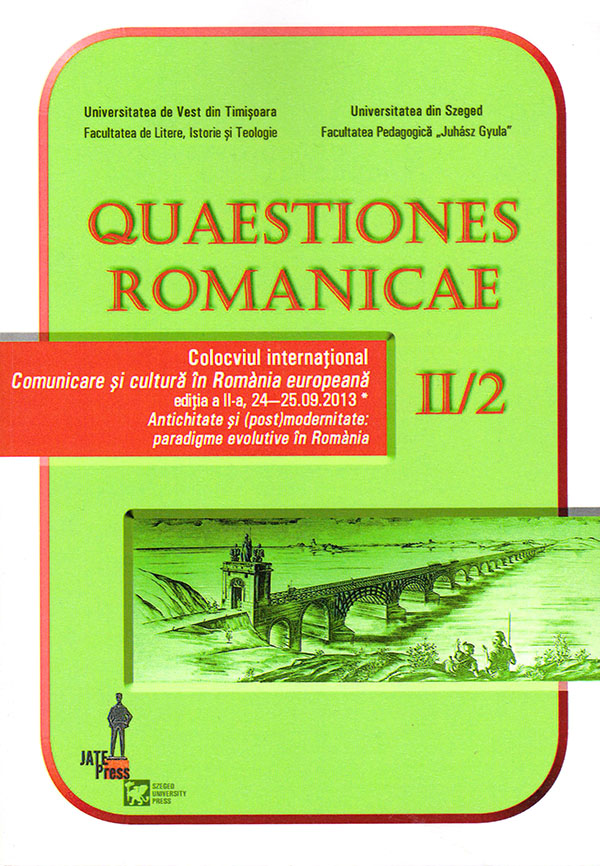Rolul episcopilor în Antichitatea târzie: moştenirea constantiniană
Abstract: (The Role of Bishops in Late Antiquity: Constantine’s Legacy) In the eighty or so years that elapsed between the so-called Edict of Milan (313 A.D.) and the anti-pagan legislation of Theodosius I, the Christian church and its bishops had gained a strong position within the Roman state. Most historians would also agree that Christianity itself was by now a powerful factor in society at large, even though it was still very far from universally embraced. An emphasis on Christianization in all its forms – belief, practice, art and architecture, social organization – is very much part of the modern concept of ‘late antiquity’.In the first place, in the post-Constantinian period churches themselves were simply more visible. Once persecution officially ended, the way was opened for the development of ecclesiastical architecture as such. Constantine himself had been a great church- builder, and later emperors followed his example. However, the new churches were not just decorative or cultic buildings; many were the preserve of local bishops, and provided the setting for the moral, social and religious teaching that was a central part of the bishop’s role. We know of many powerful bishops during this period. Their influence extended well beyond what in modern terms would be purely church matters. Constantine had set a precedent in giving them secular jurisdiction. Secondly, no single figure seems to encapsulate the changes and transformations of late antiquity better than the Christian bishop does. Bishops figure prominently in the scholarly literature about this period. The common underlying assumption of such studies tends to be that the rise of Christianity goes hand in hand with the rise of the bishop to political prominence, a rise whose lasting consequences reverberate into the Middle Ages. The authority of the bishop is a multifaceted and ever-mutating construct that continued to change as individuals adapted, necessity dictated, and circumstances permitted. Constantine’s laws granting bishops extensive administrative rights and obligations are traditionally regarded as the touchstone of church-state relations in this formative period.This study proposes a critical reassessment of Constantine’s measures in order to show that, rather than absorbing the bishops into the apparatus of imperial administration, they merely confirmed the existing episcopal oversight over practical matters that were considered to be of particular concern to Christians in general. A more significant change that was heralded by the reign of Constantine was the open access to the imperial court that the bishops now enjoyed.
Keywords: spiritual authority, bishop, imperial legislation, Constantine the Great, Church.
Rezumat: Între aşa-numitul Edict de la Milano (313 d.H) şi legislaţia anti-păgână a lui Teodosie, Biserica creştină şi episcopii săi au câştigat o poziţie puternică în societatea romană. Cei mai mulţi istorici par a fi de acord asupra faptului că creştinismul în sine a fost un factor important în societatea mai largă din această perioadă, chiar dacă el a fost încă departe de a fi adoptat pe scară largă. Un accent pe creştinare în toate formele sale – credinţă, practică şi organizare socială – face parte într-o mare măsură din conceptul modern de „Antichitate târzie”. În primul rând, în perioada post-constantiniană, bisericile au devenit pur şi simplu mult mai vizibile, însă ele nu au fost doar clădiri de cult, ci multe dintre ele au fost locul prin intermediul căruia episcopii locali şi-au furnizat învăţătura lor religioasă. Influenţa episcopilor s-a extins însă mult dincolo de jurisidicţia ecleziastică. În această privinţă, Sf. Constantin cel Mare a stabilit un precedent în a le da episcopilor o jurisdicţie laică. În al doilea rând, nicio altă figură nu pare să fi întruchipat mai bine schimbările şi transformările Antichităţii târzii decât episcopul creştin. Episcopii ocupă un loc central în literatura de specialitate dedicată acestei perioade. Ipoteza comună care stă la baza acestor studii se referă la faptul că ascensiunea creştinismului merge mână în mână cu creşterea rolului politic al episcopului. Autoritatea episcopului este un construct cu multiple faţete şi în continuă mişcare, deoarece statutul episcopului a continuat să se schimbe în funcţie de diverse circumstanţe şi necesităţi. Legile imperiale ale Sf. Constantin, prin care se acordau episcopilor drepturi extinse şi diverse obligaţii administrative, sunt considerate în mod tradiţional ca fiind piatra de temelie în ceea ce priveşte relaţiile dintre stat şi biserică din această perioadă. În acest sens absorbirea episcopilor în aparatul administraţiei imperiale a permis o supraveghere episcopală accentuată asupra problemelor practice şi cotidiene ale creştinilor, fapt care a permis identificarea rolului episcopului cu cel al binefăcătorului public (patronus).
Cuvinte cheie: autoritate spirituală, episcop, legislaţie imperială, Constantin cel Mare, Biserică.
